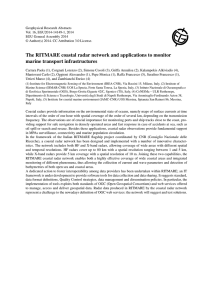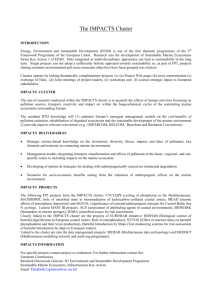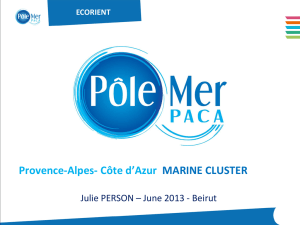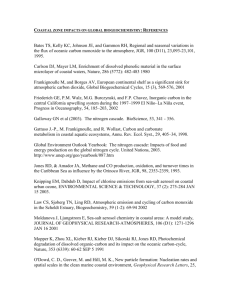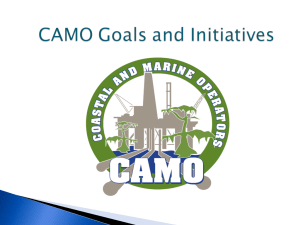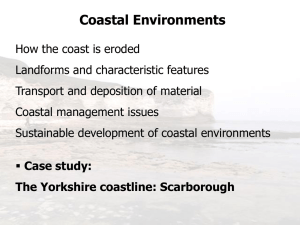COASTAL WATER QUALITY: Its Effect on Health and the Environment
advertisement
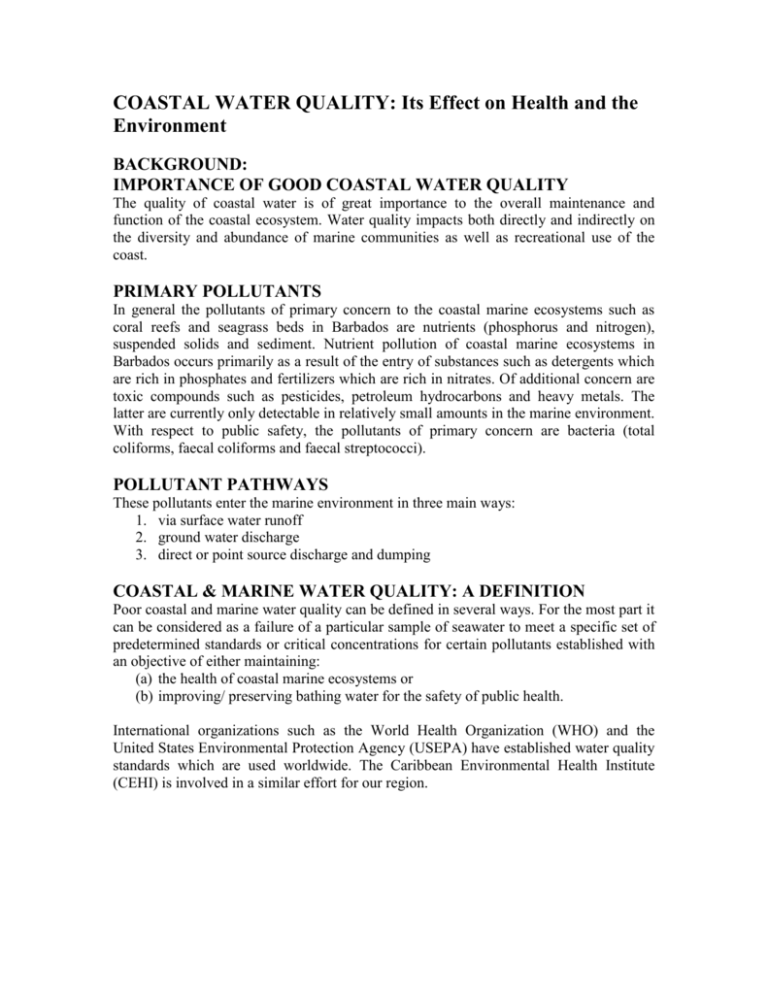
COASTAL WATER QUALITY: Its Effect on Health and the Environment BACKGROUND: IMPORTANCE OF GOOD COASTAL WATER QUALITY The quality of coastal water is of great importance to the overall maintenance and function of the coastal ecosystem. Water quality impacts both directly and indirectly on the diversity and abundance of marine communities as well as recreational use of the coast. PRIMARY POLLUTANTS In general the pollutants of primary concern to the coastal marine ecosystems such as coral reefs and seagrass beds in Barbados are nutrients (phosphorus and nitrogen), suspended solids and sediment. Nutrient pollution of coastal marine ecosystems in Barbados occurs primarily as a result of the entry of substances such as detergents which are rich in phosphates and fertilizers which are rich in nitrates. Of additional concern are toxic compounds such as pesticides, petroleum hydrocarbons and heavy metals. The latter are currently only detectable in relatively small amounts in the marine environment. With respect to public safety, the pollutants of primary concern are bacteria (total coliforms, faecal coliforms and faecal streptococci). POLLUTANT PATHWAYS These pollutants enter the marine environment in three main ways: 1. via surface water runoff 2. ground water discharge 3. direct or point source discharge and dumping COASTAL & MARINE WATER QUALITY: A DEFINITION Poor coastal and marine water quality can be defined in several ways. For the most part it can be considered as a failure of a particular sample of seawater to meet a specific set of predetermined standards or critical concentrations for certain pollutants established with an objective of either maintaining: (a) the health of coastal marine ecosystems or (b) improving/ preserving bathing water for the safety of public health. International organizations such as the World Health Organization (WHO) and the United States Environmental Protection Agency (USEPA) have established water quality standards which are used worldwide. The Caribbean Environmental Health Institute (CEHI) is involved in a similar effort for our region. WATER QUALITY MONITORING IN BARBADOS Existing water quality monitoring programmes in Barbados are designed to monitor pollutants in drinking/ potable water and to monitor bacterial levels at bathing beaches. The Coastal Zone Management Unit (CZMU) conducts monitoring of mainly marine surface water samples. This is part of the effort to maintain the health and functional dynamics of nearshore and offshore marine ecosystems, in particular coral reefs and seagrass beds. The CZMU also collaborates closely with the Environmental Protection Department (EPD) which is the legal agency responsible for conducting coastal and groundwater quality monitoring, although with a more specific emphasis on its quality for bathing and recreational use, in the former case. In the latter case EPD also undertakes the water quality monitoring of groundwater for irrigation purposes. PRINCIPAL WATER QUALITY MONITORING SITES Water quality monitoring has been taking place for many years on the south and west coasts of Barbados: at sites stretching from Silver Sands on the South coast to as far North as Maycock’s Bay. Some of the sites routinely sampled for bacterial levels by the EPD both in the dry and wet seasons are: Heywoods, Mullins, Folkestone, Paynes Bay, Fitts Village, Batts Rock, Brandons, Carlisle Bay, Drill Hall, Worthing, Rockley Beach, St. Lawrence and Enterprise Beach. EFFECTS OF POOR WATER QUALITY ECOSYSTEM AND HUMAN HEALTH ON COASTAL Poor water quality can affect vital coastal ecosystems such as coral reefs in a number of different ways: the rates of growth of corals constituting a reef may be inhibited or reduced by elevated levels of suspended particulate matter (SPM) present in the water column above them. High levels of SPM in coastal and marine areas are typical of surface water events induced by heavy rainfall or other over-ground water flows. Such events induce high levels of turbidity in the water column over corals and ultimately reduce much of the light penetration to depths that would normally occur under optimal conditions. When this occurs the photosynthetic rates of zooxanthellae drop and the coral essentially becomes starved of food for growth and reproduction. With high SPM levels over reefs settlement of the sediment on the surface of the can occur. When this happens, the corals become physically smothered and they expend additional energy in cleaning their surfaces by producing copious mucous secretions hence reserving less energy for growth. Poor water quality can also result from the substantial nutrient loading of coastal waters; a phenomenon known as eutrophication. When this occurs coral can be effectively “out competed” for light and space and even smothered by a consequent dramatic increase in algal abundance. This rapid increase in algal concentrations usually imparts a distinctly green colouration to the water, confirming eutrophic conditions. The increase in algal concentrations in a relatively short period of time occurs because the algae are able to utilize nutrients quickly as these conditions simulate the presence of fertilizer to algae. Coral reef ecosystems can also be adversely affected by the lack of recruitment of new corals to the reef. Juvenile corals require clean, hard substrates on which to settle and grow. If the availability of good substrate on the reef is severely limited because of contamination by sediment settlement or by the presence of large amounts of colonizing algae due to eutrophication, then recruitment of juvenile corals to the reef system will be minimal. Sustained exposure to eutrophic conditions, high sediment suspension and direct chemical action of pollutant discharges all increase coral mortality. This will ultimately impact negatively upon the health and general viability of these valuable coastal ecosystems. Poor coastal and marine water quality has the potential to adversely affect public health through either internal or even external body contact. Exposure to elevated levels of coliform bacteria in coastal bathing waters can increase one’s susceptibility to a range of mild to severe bacterial infections such as skin rashes, stomach infections and ear infections, among others. For additional information, contact: The Director Coastal Zone Management Unit Bay Street St. Michael BARBADOS Tel: (246) 228-5950/1/2/3 Fax: (246) 228-5956 Email: coastal@caribsurf.com



